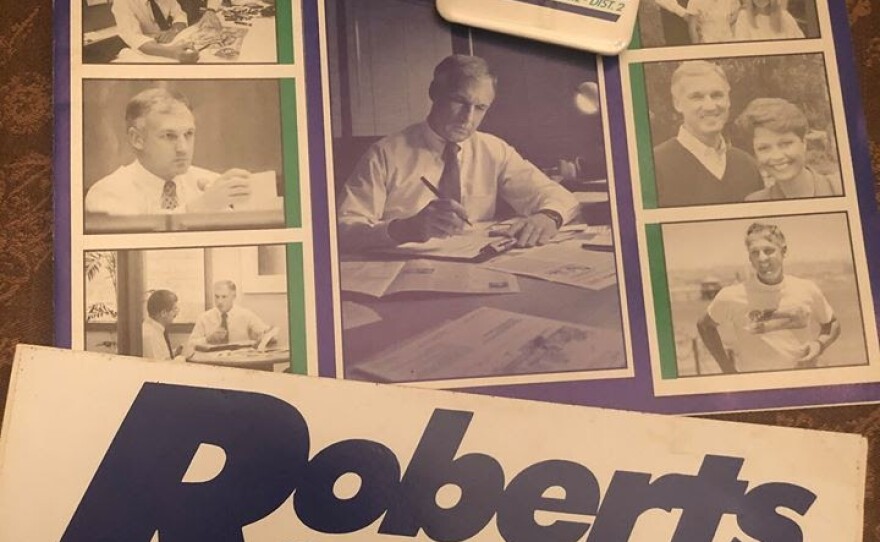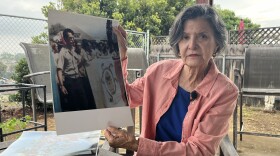Supervisor Ron Roberts attends his final meeting on the San Diego County Board of Supervisors on Wednesday, ending more than three decades in elected office. KPBS spoke with him about his time in local government and what he hopes for the future.
The following transcription has been lightly edited for clarity.
Q: You were first elected to the San Diego City Council in 1987? '88?
A: '87. Yeah, I was seated on Dec. 7, 1987.
Q: So that's where you started. You then moved on to the County Board of Supervisors. You've also served on a lot of regional and statewide boards and commissions. What's your proudest accomplishment?
A: Wow. That's like saying which is your favorite kid, you know? I feel every day I'm reminded how profound a change the Waterfront Park is here at the county building. And what I see especially, you come out in the summertime and the kids are splashing around. To know that you removed and replaced parking and created one of the most successful parks in San Diego, it's hard to look beyond that.
Q: So Waterfront Park – I mean, San Diegans can be very touchy about parking. This started as a surface parking lot. You've now turned into a place that people can walk and enjoy and bring their families. Was there a fight about that? Was it a difficult battle to get it done? And what did you learn from that?
A: You learn to persevere. I mean that was almost 15 years from the time I first suggested it to the time we actually got it opened. I had to convince my colleagues, and other people, we're going to have parking. We've replaced the parking. We have a great structure over in Little Italy, we've got underground parking here. We've still got a convenience factor for everyone. But there were people that have offices at this end of the building that said, "Well gosh, we're going to have to walk all the way down there, or we're going to have to walk to the parking structure in Little Italy." A little bit of walk is probably good for us.
Q: You entered office really at the height of the AIDS epidemic. You also played a role in the city of San Diego getting its first AIDS hospice, the Truax House in Bankers Hill. What did you learn from that public health crisis, and how did you carry it forward in overseeing public health at the county?

A: Well first of all, when I was elected it was a new subject, so to speak, but it was happening very, very fast. In fact, I had a couple of neighbors who both died in short order just after, not too long after I was seated. And it drove home the fact it was a real crisis. This was affecting people. And at that time you didn't know, are in danger if you shake hands with people? What is this all about? I had to have people that really were knowledgeable. And that's one thing I've learned. Find people that really know what is going on. And I think because of that, because we've listened, we're making a lot of progress. I'm not saying it's not a crisis today, because it still is. But I was really proud this year when we were able to announce that our Getting to Zero campaign is getting us there. We had last year over a 20 percent decrease in the number of AIDS cases. And this is at the end of 2017. I don't have the numbers yet for 2018. But we are down now, the number of new cases in San Diego is down at the level where we were in 1984. That's a significant decrease. It's taken a while to get there, and you know, there's new therapies, new drugs. You know, we're driving that message in advertising. But we're going to get there, and I've listened to people, you know, people like Todd Gloria have been extremely helpful in keeping me informed. Terry Cunningham – who has been from day one, way, way back, has been truly probably the person that I've gone to most frequently to help understand what do we need to do. Let's put a program together, let's get working on this.
The Truax House — I along with (then Mayor Maureen) O'Connor, God bless her, we were concerned. You know we wanted to do this, but we thought, boy, that's going to be explosive probably if we announce at that time. I said why don't we do it at midnight on a Friday night, you know, when we make our public announcement? Well we didn't do that, and we did it at a more convenient time so that people could respond. I'll never forget when I turned on my TV to see, okay, what was the neighborhood — and this guy came on and said, "This was a good idea to be doing this for people." And it moved me emotionally in positive way, and I thought, okay we're going to get there.
Q: You started your time in elected office during that public health crisis. In some ways you ended, almost, in another public health crisis with hepatitis A. That was a really difficult thing for the county and the city to really get their hands on, to tackle. What did you learn from that whole crisis?
A: Well one of the things was – there's a background story there that someday will probably be told. There were people that said, "Well you didn't declare health emergency soon enough." And nobody understands the real crisis was we didn't have access to vaccine. And we were worried that if the general public stampeded to get vaccine, we weren't going to be able to have vaccine for the people that were on the street. So while it appeared like people weren't doing anything, people were working feverishly. We were working with the hospitals, we were working with the federal government. And we went on the private market. We spent a lot of money for about 30,000 doses of the vaccine so that we could respond. But we were really afraid if it became a community-wide panic, that we were going to be in real trouble. And that's why there was a little deferring in terms of declaring the public health crisis. But it was being treated, and successfully being treated getting to those people who were on the streets with a whole new set of organized help.
Q: You serve on the California Air Resources Board. That agency just released a report pretty recently that said that California is not going to meet its long term greenhouse gas reduction goals. And the reason is that metropolitan planning organizations — they aren't reducing vehicle miles traveled. People are still driving a lot. They're still driving longer distances. What do you think needs to change in order for people to really make that shift in lifestyle and start getting out of cars and using more sustainable forms of transportation?
A: Well first of all I'm not in agreement with that analysis. From the very first time I took office here, in fact in the campaign that I had originally for this office, I ran against a guy who said, "The only way we can reduce air pollution is to reduce driving." I didn't believe it, okay? And if you look at that metric, we have significantly reduced air pollution while driving has gone up, while population has gone up. And in fact he said, the other thing, "We gotta stop the growth of San Diego. We cannot be building houses." It almost sounds like a replay of what we're hearing today. That becomes part of the mantra that people use to not do things that we really need. Housing is really important, but I hear, "Well yeah, but it's going to increase traffic, or you know, people are going to drive." If you look at the changes to the autos, if you look at how we're going, the increases in electric cars, both all electric and hybrid cars, is having a significant impact. To use the metric that just says driving, we want to drive fewer gasoline miles, but driving electric cars — you know, I understand it's an infrastructure problem. I don't think that is what's going to prevent us from getting and accomplishing our goals in terms of greenhouse gases.
Q: Well the ARB has experts on staff. You know, they're very smart people, they do the math on this. They make assumptions about electric vehicles, about hybrids, about reducing carbon in fuel. And they've come to the determination that we really do have to reduce driving to some extent, and faster than what we're doing now. Are you saying you just don't buy it?
A: I don't buy it. But you know, don't be assuming that because there's a lot of smart people they always come to the right conclusions. A few years back they decided we can't allow people to have black cars anymore, and they proposed a regulation that would do a lot of things but would not allow any more cars to be black cars. And they were doing this because of the heat gain in the cars. The color of the car has very little to do with the heat gain in the car. The car gains heat because it's covered with windows. And what they were worried about, when somebody gets into a hot car, they have to put their air conditioning on right away. So they wanted to cool the cars down while they were parked. Painting them black or purple, it didn't make a whole — but you had very bright people that came to the conclusion — and in fact the board adopted that with one dissenting vote. I was that dissenting vote. About two or three months after that, they rolled it back. I didn't say I told you so, but each of them knew what I was thinking because it was a stupid rule. And it was brought to us by pretty bright people. And I try to say they heat up largely because of the window area in the car. And then they were saying, well let's put a coating on the windows. And then they found that coating would not allow you to use cell phone equipment within the cars. They had to back off completely and come to a more sensible solution. So don't be impressed with experts just because they claim to be experts. It doesn't mean they're right.
Q: Right now San Diego has a growing economy, low unemployment, and yet at the same time we're seeing a lot more people on the streets, a lot more people struggling to afford a place to live. And a lot of people see this as evidence of a failure of public policy. How do you respond to that?
A: Well there's probably some truth in that. I'm not sure, you know there's a lot of different public policies. We're not building enough affordable housing. I grew up in public housing. Linda Vista. It was a large government housing project. It was built in World War II. And we lived in what were called temporary units. They're all torn down because they were fire traps. But the fact of the matter is there was a time I think when we responded — in that case I think over 3,000 units were built in very, very short order. We couldn't do that today if our lives depended on it. We have rules and regulations that are well intended, but they're used by people largely to say, "No, we don't want housing." And if you say affordable housing: "We don't want them." I mean I'm going through this. I'm working on at least a half a dozen different projects right now. And I'm really hopeful that we can do them. The fact of the matter is right across the board we're not building adequate numbers of housing in San Diego. And people say, "Well you need it in this price range." Build housing. Build affordable if you can, but build anything that you can, in a decent way with environmental sensitivity. But for us to come with rules and regulations that preclude that from happening, and empower people to stop it for reasons that have nothing to do with the merit of environmentalism or greenhouse gas or anything else, I think that's one of our biggest crises right now.
Q: When you look at the current political landscape in San Diego, what's your greatest hope and what's your greatest fear?
A: My hope is always that we do things to take this incredibly beautiful area that we're all very fortunate to live in and make it better. That doesn't mean just hang on and take advantage of the fact that we have a lot of sunshine. But find ways to make it better. And I've tried to work on that. I spent a lifetime on public transit, because we really didn't have much in the way of public transit. I'm really proud now, the mid-coast line that's under construction — I won't be in office when it's done, but I don't think there's anybody that's put more hours into making that happen. It's going to be an incredibly successful line. Don't just accept the fact that these things are difficult to get done or they may cost money. Find creative ways to get things done. There's still a lot that's needed in San Diego. Build communities. It's not just housing. It's building a community. It's building a context. Work with your nonprofits, work with your business community. My life has been here. I was moved here when I was a very young kid. The best thing that's ever happened to me was my father said, "We're going to move you to San Diego." And I thought, "Where's San Diego?"
Q: How about your greatest fear?
A: You know, we see periods sometimes where we might be our own worst enemy. We get into elections and things and the people that we get into those offices are great on rhetoric and short on performance. My hope is that with everything that's happening, that the people that we elect, who now are going to be on a much shorter lease with term limits — they're not going to have the luxury I had of working on projects that were going to take over a decade to get completed, but that are incredibly important — I hope that they stay focused and get everything that they can get done. I'm kind of worried about the term limits and the long term impact it might have. You know this thought that just by churning people over, to have county supervisors that are only here for eight years — the county budget is bigger than 15 states in the United States. You have five people that ultimately are responsible for that. The first couple years that you're here, you do an awful lot of learning. So that means then you only have say five or six years left after that, assuming you get elected the second time, which doesn’t always happen. So I guess I get concerned about some of the backlashes that we see that are emotional reaction by an electorate. You know my hope, we always depend — in a democracy, everything revolves (around) having people that are informed casting those votes.
Q: Your successor, Nathan Fletcher, is taking office very soon. You endorsed his opponent in the election. Do you have any advice for him?
A: He and I have had a couple of private conversations. And I would tell you — look, you don't tell the guy that's coming in after you what to do. I've shared experiences, and I have hopes. I mean I want him to succeed, and I've told him that. It doesn't make any difference who I supported. You know, you've got to get over that and say, 'Okay, I want this to remain one of the best managed, one of the counties that delivers services at a higher level than most any other in the country.'
Q: You've been in office for more than 30 years now. What's next?
A: I wish I could tell you that. People are suggesting things. As recent (as) this morning I ran into somebody who needs some help with a nonprofit. I want to have a job that's like this, and I don't mean in a political sense. Something I can feel like at the end of the day you're making somebody's life better because of what you've done.






